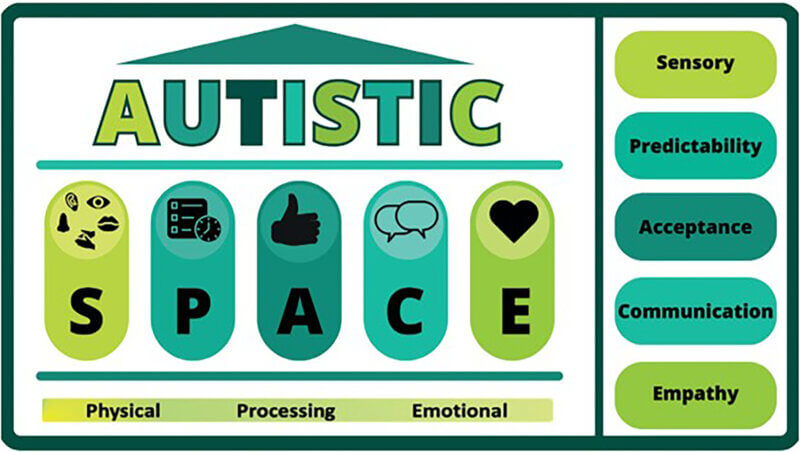
Autistic SPACE – A Framework for Inclusive Education
I first heard about the Autistic SPACE framework at the September 2025 Autism Europe Conference. Autistic Consultant Anesthetist and Clinical Associate Professor at the School of Medicine, University College Dublin, Dr. Mary Doherty, co-created Autistic SPACE to meet the needs of autistic people in healthcare settings. The acronym stands for these five core domains:
• Sensory needs.
• Predictability.
• Acceptance.
• Communication.
• Empathy
The framework of these 5 core domains has become a roadmap for the practical enactment of inclusive education for autistic students in school settings. Using an extensive research base, the domains of Autistic SPACE can be interpreted from an education perspective.
While inclusion may be a key priority within education, in traditional education settings students are expected to fit in to pre-existing education models that often intensify the sensory, social and emotional challenges that autistic people experience. The idea of inclusion is to make adaptations to meet the student’s needs which includes individualized support, tailored teaching, and approaches that are sensitive to the communicative style, sensory and emotional needs of autistic students.
There are several reasons why inclusive education is a challenge for educators. They are:
- a lack of resources
- busy classrooms with diverse student needs
- misinterpretation/misconception of autistic traits
- not understanding distressed behavior and the reasons why it occurs
- inadequate teacher training for autistic students
Failing to prepare and support teachers to work with autistic students can result in increased stress, isolation, burnout and poor staff retention. Inclusive education must move beyond deficit-based models of autism and build on the lived experience of autistic students and autistic teachers to create learning environments that prioritize autistic wellbeing and value strengths in a neurodiversity affirmative setting.
Let’s explore how the Autistic SPACE framework can be applied to educational settings and help busy teachers to recognize and meet autistic student needs.
Figure 1. Autistic Sensory, Predictability, Acceptance, Communication and Empathy (SPACE) Framework (Doherty et al., 2023).
Sensory Needs
Mainstream classrooms are stimulating environments with bright lights, noise, crowded spaces and student movement that autistic students can find overwhelming. While sensory stressors may be undetectable to non-autistic people, sensory discomfort can hinder autistic students’ academic learning, impact educational experiences, and have implications for autistic students’ sense of safety.
Most autistic individuals experience both hypersensitivity (over-responsiveness) and hyposensitivity (under-responsiveness) to a wide range of stimuli and are usually a combination of both. Sensory overload, or sensory overstimulation, happens when there is more input coming in from the senses than the brain can sort and process. Autistic people tend to be more hypersensitive to sensory input, making sensory overload more likely. Sensory overload can lead to involuntary meltdowns or shutdowns.
The sensory domain may help teachers to see how needs and tolerances fluctuate and what can be done to reduce sensory barriers to learning. Here are some ways to support students:
- listen to student voice about sensory experiences
- assess the environment from a sensory perspective
- develop a sensory profile for the student
- use individualized sensory adaptations (sensory tools, movement breaks, quiet spaces, alternative seating)
- be flexible because sensory needs can be context dependent (ex. noise cancelling headphones when in a gymnasium)
Predictability
Predictability, routine, and structure can reduce an autistic person’s anxiety. Schools have rapidly changing environments so increasing predictability, planning for and supporting students to manage and cope with change is important in the school context. We can:
- use visual supports (for changes, transitions)
- establish timetables and create visual schedules
- prepare for transitions in advance (25% of the school day is transitioning)
- have a structured environment
- have clear expectations, routines and procedures
- keep things familiar and consistent with teachers, routines and procedures
Acceptance
Acceptance of difference and the necessity of flexibility differentiates inclusion from integration. For autistic students, a sense of belonging and relationships within the school environment are more important than merely being in the mainstream setting.
If there is fear of rejection or ridicule, autistic students may mask their expressions of autistic identity to ‘fit in’ or ‘blend in’ in the school setting. Here are some ways to support autistic students’ sense of acceptance and inclusion in school.
- adopt a strength and rights-based practice
- promote and support interests
- support development of self-acceptance and self-identity
- support empowerment, self-determination, autonomy and advocacy
- listen to the person and accept their preferences and decisions
- create a school-wide community of acceptance
- promote opportunities to learn about neurodiversity
- accept responsibility to make adaptations to the school environment
Communication
Communication difficulties may arise when autistic people interact with non-autistic people. Autistic researcher Damien Milton talks about the double empathy problem which comes into play in social situations. This means the communication breakdown between autistic and non-autistic people is a two-way issue, caused by both parties’ difficulties in understanding. It’s not a one way street with the onus being on the autistic person to understand context and meaning.
Communication differences may include differences in the use of gaze, eye contact; gestures and posture and may be open to misinterpretation. Sensory experiences may impact an autistic individual’s ability to speak or respond. In situations of high stress and anxiety, entire loss of speech may happen.
Between 25%–35% of autistic children are non-speakers with few to no spoken words, yet their abilities and needs cannot be determined by labels such as ‘verbal’ and ‘non-verbal’.
If there is a focus on compliance, student preferences and priorities are ignored and they are denied the autonomy required for safeguarding.
Parents/guardians will have valuable insights and are important advocates for their autistic child’s needs. Be aware that unseen and unmet needs can impact student mental health, resulting in frequent school absence. We can support the communication needs of autistic students by:
- presuming communication competence
- accepting all ways of communication (AAC, PECS, sign language)
- understand that communication can be reduced by stress, anxiety, and sensory overload
- use visuals/gestures with verbal communication
- communicate clearly with less language and superfluous talk
- know and support the student’s language processing needs
- don’t use idioms, sarcasm, metaphors, irony, or exaggeration
- assess your own communication
- ask for parental/guardian input
Empathy
Cognitive empathy refers to the ability to recognize one’s own and/or another’s emotional state and perspective, while affective empathy refers to the ability to experience and respond to another’s emotional experiences or expressions. It is a myth that autistic people can’t feel empathy. The truth is they experience or express empathy differently; they report experiencing hyper-empathy, to the point of needing to ‘shutdown’ to cope with emotional onslaught.
Damien Milton says that autistic people have different ways of experiencing and understanding the world due to sensory, perceptual and cognitive differences and these differences can be difficult for non-autistic individuals to understand. The onus has been on the autistic person to rectify communication differences in order to fit with the non-autistic majority.
At school, educators may struggle to empathize with the autistic student experience of classroom activities and environment, resulting in a mismatch of between the needs of the student and the support given. If the educator lacks knowledge and understanding of autism, then the double empathy problem increases the difficulty for students. To help alleviate this, we can:
- learn about the double empathy problem
- don’t assume a lack of empathy in individuals who are autistic
- allow for processing time of a situation or event
- try to know the comprehension of a circumstance to ensure a shared understanding
- develop your own understanding and knowledge of autism by engaging with autistic individuals and their lived experience
Although the Autistic SPACE framework was developed by healthcare professionals, the autistic experience and challenges remain the same, whether in a healthcare or educational setting. Teachers have a responsibility to identify diverse learning needs and develop skills to adapt their teaching and classroom environment to support those needs. If we stick with deficit-based models in education, it is unlikely that autistic students will thrive. Autistic students shouldn’t be viewed as individuals that need to be fixed, but rather their differences valued and respected because they are a part of being human.
References
McGoldrick, E., Munroe, A., Ferguson, R., Byrne, C., & Doherty, M. (2025). Autistic SPACE for Inclusive Education. Neurodiversity, 3. https://doi.org/10.1177/27546330251370655 (Original work published 2025)
Editorial Policy: Autism Awareness Centre believes that education is the key to success in assisting individuals who have autism and related disorders. Autism Awareness Centre’s mission is to ensure our extensive autism resource selection features the newest titles available in North America. Note that the information contained on this web site should not be used as a substitute for medical care and advice.

